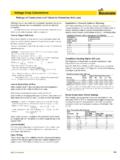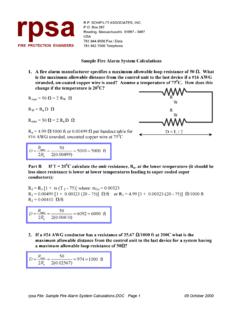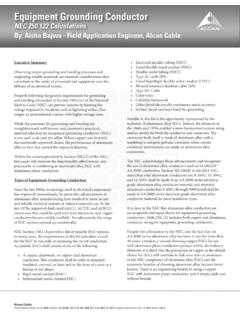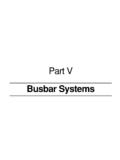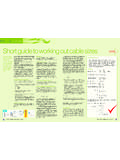Transcription of THE HOW AND WHY OF OBTAINING ACCURATE …
1 Speeding Edge, Spring 2003 SLIDE # 1 THE HOW AND WHY OF OBTAINING ACCURATE IMPEDANCE CALCULATIONSSESSION W-17 PRESENTED AT SPRING IPC CONFERENCELONG BEACH, CALIFORNIAPRESENTER LEE RITCHEYCOPYRIGHT, MARCH 2003 SPEEDING EDGES peeding Edge, Spring 2003 SLIDE # 2 WHAT IS IMPEDANCE? Impedance is the resistance to the flow of energy in a transmission line. At low frequencies, it is primarily the DC resistance of the bulk copper and is relatively small in PCB traces. At high frequencies it is primarily reactive and substantially higher than the DC or low frequency value. Reactance is both capacitive and , Eric, What is Characteristic Impedance? Printed Circuit Design, January 2000.
2 Very good Edge, Spring 2003 SLIDE # 3 WHAT IS CONTROLLED IMPEDANCE? Controlling impedance is keeping all sources of impedance mismatch in a transmission line within limits that don t result in malfunctions caused by reflections at impedance changes. Perfect matching is not necessary. Good enough is all that is needed. Good enough can and needs to be calculated by the creator of the design rule set. Perfect impedance matching wastes time and money and does not contribute to better Edge, Spring 2003 SLIDE # 4 WHY IS CONTROLLED IMPEDANCE NEEDED? Energy in the form of an electromagnetic wave propagates down transmission lines. At points along the transmission line where there are impedance changes, some of that energy reflects back to the source.
3 This reflected energy can destructively degrade a Edge, Spring 2003 SLIDE # 5A SIGNAL WITH CONTROLLED IMPEDANCERs = 25 ohms50 ohm nSEC/ft 12" TLPassiveReceiverLinearDriverZout = 25 ohmsVout = 5 VSERIES TERMINATED TRANSMISSION LINEC omment: Simple Series Terminated Transmission Line volts V/div 2 nsec/divTransmission Line OutputTransmission Line InputBoth Logic Transitions ShownSpeeding Edge, Spring 2003 SLIDE # 6A SIGNAL WITHOUT CONTROLLED IMPEDANCE50 ohm nSEC/ft 12" TLPassiveReceiverLinearDriverZout = 25 ohmsVout = 5 VUNTERMINATED TRANSMISSION LINEypyComment: Simple Series Unterminated Transmission V/div 2 nsec/div+ VoltsBoth Logic Transitions ShownTransmission Line InputTransmission Line OutputSignal LimitsSpeeding Edge, Spring 2003 SLIDE # 7A VERY POORLY MANAGED TRANSMISSION LINE volts V/div 5 nsec/divTTL "1"TTL "0"Speeding Edge, Spring 2003 SLIDE # 8A TYPICAL CIRCUITZ0 ZLOADZOUTVOLTAGESOURCEM inimum reflections occur when Zout = Z0 = energy transfer occurs when these conditions are real voltage sources have some output impedancethat is not zero.
4 This impedance can be resistive,reactive, nonlinear or any combination of voltage sources have zero output impedanceand Vout does not drop as the current load SOURCETRANSMISSION LINELOADTYPICAL TRANSMISSION LINE SYSTEMVLOADVOUTVSOURCES peeding Edge, Spring 2003 SLIDE # 9 THE REFLECTION EQUATIONZl= LOAD IMPEDANCE OR DOWNSTREAM IMPEDANCEZO= LINE IMPEDANCE OR UPSTREAM IMPEDANCE% = AMOUNT OF INCOMING SIGNAL REFLECTED%= +100 ZZZZlOlONote: This equation applies to any impedance mismatch. UseZo for the signal source side of the mismatch and Zl for the load side of the Edge, Spring 2003 SLIDE # 10 WHAT IS A TRANSMISSION LINE? A transmission line is any pair of conductors that are used to move electromagnetic energyfrom one place to another.
5 In printed circuit boards, this is typically a trace and one or two power planes. Other examples of transmission lines: Power lines are transmission lines. Waveguides are transmission lines. TV twin lead is a transmission line. Coaxial cable is a transmission line. Twisted pairs are transmission : All of these have a characteristic impedance and use the same rules for managing signal Edge, Spring 2003 SLIDE # 11A MECHANICAL TRANSMISSION LINEM echanical energy is coupled from one end of the line of masses to the other with an acoustic wave that travels at the speed of sound through the Edge, Spring 2003 SLIDE # 12 STRIPLINE CIRCUIT WITH ELECTROMAGNETIC FIELDSB ogatin, Eric, What is Characteristic Impedance?
6 Printed Circuit Design,January 2000. Very good Edge, Spring 2003 SLIDE # 13whhtSignal planePower planePower planeSymmetrical or Balanced StriplinePower planePower planettwBBCA symmetrical StriplinetSignal planetSignal planewwhhSurface MicrostriplineBuried MicrostriplinePower planePower planeFOUR BASIC TYPES OF PCB TRANSMISSION LINESNOTE: VARIABLES ABOVE CORRESPOND TO THOSE USED IN THE IMPEDANCEEQUATIONS IN THIS Edge, Spring 2003 SLIDE # 14 TRADITIONAL METHODS FOR CALCULATING IMPEDANCE Equations have been developed over time that allow engineers and fabricators to calculate the impedance of PCB transmission lines based on the geometry and the dielectrics being used.
7 All equations are partial solutions, valid over a limited range of variables. When equations don t yield ACCURATE results, iterative adjustments have been made to make the equations Edge, Spring 2003 SLIDE # 15A PRACTICAL IMPEDANCE EQUATIONFOR SURFACE MICROSTRIPer=RELATIVE DIELECTRIC CONSTANTH = HEIGHT OF TRACE ABOVE PLANEW = TRACE WIDTHT =TRACE THICKNESSZO= TRACE IMPEDANCE IN OHMSANY DIMENSION SYSTEM IS APPLICABLENOTE: VALID FOR 5<w<15 MILS ++= is that obtained from velocity measurements made with a more precise calculation can be obtained using a 2D field solver which the author Edge, Spring 2003 SLIDE # 16 BURIED MICROSTRIP IMPEDANCE EQUATIONZO= TRANSMISSION LINE IMPEDANCE (OHMS)H = HEIGHT OF LINE ABOVE POWER PLANEW = TRACE WIDTHT =TRACE THICKNESSer = RELATIVE DIELECTRIC CONSTANTV alid for 5 < W < 15 mils, valid for any dimension systemAssumes at least 5 mils of dielectric lying on top of trace.
8 ZHWTWer043 0375 048106 76109= + +. more precise calculation can be obtained using a 2D field solver which the author developed by Martin Marietta in mid Edge, Spring 2003 SLIDE # 17 ASYMMETRIC STRIPLINE IMPEDANCE EQUATION Z0= TRANSMISSION LINE IMPEDANCE B = TRACE TO PLANE SPACING C = TRACE PLANE TO TRACE PLANE SPACING T = TRACE THICKNESS W = TRACE WIDTH er= relative dielectric constant of insulator FOR C = 0, equation applies to centered stripline Valid for 5 < W < 15 milsZBBCTeBTWTr0801419 208= ++ ++ ()ln.()(.)A more precise calculation can be obtained using a 2D field solver which the author developed by DEC in the mid Edge, Spring 2003 SLIDE # 18 PROBLEMS WITH TRADITIONAL IMPEDANCE CALCULATION METHODS All impedance calculating equations are approximations.
9 Outside their range of validity, the results are often significantly off. This coupled with incorrect dielectric constants (er) for the insulating materials results in many errors. Fabricators with significant experience building controlled impedance PCBs know this and compensate empirically for Edge, Spring 2003 SLIDE # 19 COMPARING FIELD SOLVER RESULTS TO EQUATION RESULTSSMS = Surface microstrip, EMS = embedded microstrip, CSL = centered striplineFIELD SOLVER vs. EQUATIONS0102030405060708045678910 TRACE WIDTH (M ILS)IMPEDANCE (OHMS)EQ S MSEQ B MSEQ CS LFS SMSFS BMSFS CSLEr = 4, Th = mils, Height = 5 milsSpeeding Edge, Spring 2003 SLIDE # 20R, L, C TRANSMISSION LINE MODELO -R -L -R -L -R -L -R -L -OI I I IC C C CI I I IG G G GO = END OF LINE R = RESISTANCE PER UNIT LENGTHG = GROUND PLANE L = INDUCTANCE PER UNIT LENGTH C = CAPACITANCE PER UNIT LENGTH Model assumes ground is a plane of negligible inductance and following equations permit one to calculate the reactance ofcapacitors and inductors as a function of Xc = Capacitive Reactance XfLL=2 XL = Inductive ReactanceSpeeding Edge.
10 Spring 2003 SLIDE # 21 THE IMPEDANCE EQUATIONZO=CHARACTERISTIC IMPEDANCE OF LINELO= INDUCTANCE PER UNIT LENGTHCO= CAPACITANCE PER UNIT LENGTHRoCLZOOO+=This equation is useful only when there is a ready means for determining values per unit capacitance is added to a transmission line (example: periodic loads)the impedance goes down. Note that impedance is independent oflength and Edge, Spring 2003 SLIDE # 22 HOW TO DETERMINE LoAND Co Lois a function of the shape of the transmission line and its proximity to other conductive structures. Cois also a function of the shape of the transmission line and its proximity to other conductive structures. It is also a function of the dielectric constant of the insulation between the component parts of the transmission line (er).




